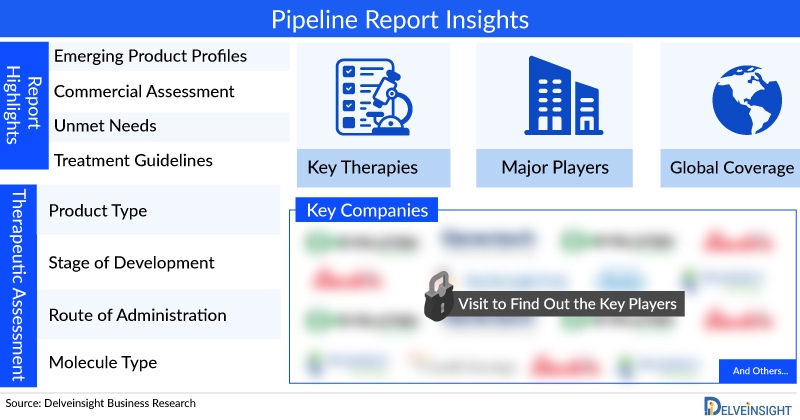DelveInsight’s “Macular Telangiectasia – Pipeline Insight, 2025” highlights the increasing interest in vision-preserving interventions, with more than 4 pharmaceutical and biotech companies actively engaged in developing therapies. Key candidates include CNTF (ciliary neurotrophic factor), being investigated via encapsulated cell technology (e.g., NT-501), and various AAV-based gene therapies aimed at restoring metabolic support to retinal cells. Early clinical data from the CNTF program have shown promising signs of structural and functional stabilization in patients with Type 2 MacTel, sparking hope for long-term retinal preservation.
Other innovative approaches in the pipeline include the use of stem cell-derived retinal progenitor cells, neuroprotective peptides, and small molecules targeting oxidative stress and mitochondrial dysfunction. Several programs are in Phase I/II development stages, reflecting the complexity of establishing robust clinical endpoints in this slow-progressing, heterogeneous disease. Nevertheless, advances in imaging biomarkers, including OCT and adaptive optics, are helping refine trial designs and patient stratification, enabling better assessment of therapeutic efficacy.
As 2025 approaches, the MacTel pipeline reflects a shift from passive monitoring to active intervention, guided by scientific advances in retinal biology and precision ophthalmology. Though challenges remain in translating experimental successes into approved therapies, the ongoing momentum suggests that disease-modifying treatments for MacTel may soon become a reality, offering renewed hope to patients facing progressive vision loss.
Interested in learning more about the current treatment landscape and the key drivers shaping the Macular Telangiectasia pipeline? Click here
Key Takeaways from the Macular Telangiectasia Pipeline Report
• DelveInsight’s Macular Telangiectasia pipeline analysis depicts a strong space with 4+ active players working to develop 4+ pipeline drugs for Macular Telangiectasia treatment.
• The leading Macular Telangiectasia companies include OXURION, Neurotech Pharmaceuticals, and others are evaluating their lead assets to improve the Macular Telangiectasia treatment landscape.
• Key Macular Telangiectasia pipeline therapies in various stages of development include THR 317, NT-501, and others.
• In March 2025, the FDA approved Encelto (revakinagene taroretcel‑lwey), the first-ever treatment for MacTel type 2. This implant uses encapsulated cell therapy to deliver ciliary neurotrophic factor (CNTF) directly to the retina, helping slow photoreceptor loss and preserve central vision.
• At the Angiogenesis 2025 virtual conference (February 2025), researchers presented Phase III data on NT‑501 (an earlier version of the Encelto implant) showing a 31–52% reduction in photoreceptor loss over two years—anatomic endpoints supported by OCT-based measures.
Macular Telangiectasia Overview
Macular Telangiectasia (MacTel) is a rare, progressive eye disease that affects the macula, the central part of the retina responsible for sharp, detailed vision. It involves abnormal dilation (telangiectasia) of blood vessels in the macula, leading to leakage, retinal damage, and gradual vision loss. There are two main types: Type 1, which is typically unilateral and associated with aneurysmal changes, and Type 2, the more common, bilateral form, often linked with neurodegenerative changes in the retina.
Symptoms usually appear gradually and may include blurred or distorted central vision, difficulty reading, or seeing fine details. The exact cause of MacTel, especially Type 2, is not fully understood but may involve both vascular and neurodegenerative mechanisms. There is currently no cure, but research is ongoing. Management may include anti-VEGF injections, laser treatment, or participation in clinical trials to slow progression and preserve vision.
Find out more about Macular Telangiectasia medication at https://www.delveinsight.com/report-store/macular-telangiectasia-mactel-pipeline-insight
Macular Telangiectasia Treatment Analysis: Drug Profile
NT-501 (Renexus): Neurotech Pharmaceuticals
NT-501, also known as Renexus, is an encapsulated cell therapy being developed for the treatment of Macular Telangiectasia Type 2 (MacTel 2). It is currently in a Phase 3, randomized, multi-center clinical trial to assess its efficacy and safety. The therapy uses a novel drug-delivery system in which human-derived cells are enclosed within a semipermeable capsule that continuously releases ciliary neurotrophic factor (CNTF), a protein believed to support retinal health. The FDA granted orphan drug designation to NT-501 in July 2012 and Fast Track status in February 2019 for the treatment of MacTel 2.
THR-317: OXURION
THR-317 is a Placenta Growth Factor (PlGF) inhibitor being developed for the treatment of Idiopathic Macular Telangiectasia Type 1 (MacTel 1). The drug is currently under evaluation in a Phase II clinical trial, targeting the abnormal blood vessel growth and inflammation associated with MacTel 1.
Learn more about the novel and emerging Macular Telangiectasia pipeline therapies.
Macular Telangiectasia Therapeutics Assessment
By Product Type
• Mono
• Combination
• Mono/Combination.
By Stage
• Late-stage products (Phase III)
• Mid-stage products (Phase II)
• Early-stage product (Phase I) along with the details of
• Pre-clinical and Discovery stage candidates
• Discontinued & Inactive candidates
By Route of Administration
• Intravenous
• Subcutaneous
• Oral
• Intramuscular
By Molecule Type
• Monoclonal antibody
• Small molecule
• Peptide
Scope of the Macular Telangiectasia Pipeline Report
• Coverage: Global
• Key Macular Telangiectasia Companies: OXURION, Neurotech Pharmaceuticals, and others.
• Key Macular Telangiectasia Pipeline Therapies: THR 317, NT-501, and others.
Explore detailed insights on drugs used in the treatment of Macular Telangiectasia here.
Table of Contents
1. Introduction
2. Executive Summary
3. Macular Telangiectasia Pipeline: Overview
4. Analytical Perspective In-depth Commercial Assessment
5. Macular Telangiectasia Pipeline Therapeutics
6. Macular Telangiectasia Pipeline: Late-Stage Products (Phase III)
7. Macular Telangiectasia Pipeline: Mid-Stage Products (Phase II)
8. Macular Telangiectasia Pipeline: Early Stage Products (Phase I)
9. Therapeutic Assessment
10. Inactive Products
11. Company-University Collaborations (Licensing/Partnering) Analysis
12. Key Companies
13. Key Products
14. Unmet Needs
15. Market Drivers and Barriers
16. Future Perspectives and Conclusion
17. Analyst Views
18. Appendix
About DelveInsight
DelveInsight is a leading Business Consultant and Market Research firm focused exclusively on life sciences. It supports Pharma companies by providing comprehensive end-to-end solutions to improve their performance. Get hassle-free access to all the healthcare and pharma market research reports through our subscription-based platform, PharmDelve.
Media Contact
Company Name: DelveInsight
Contact Person: Jatin Vimal
Email: Send Email
Phone: +14699457679
Address:304 S. Jones Blvd #2432
City: Las Vegas
State: Nevada
Country: United States
Website: https://www.delveinsight.com/

